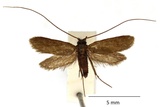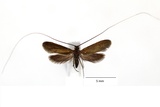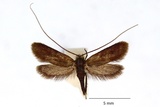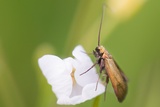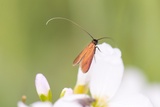Cauchas rufimitrella (Scopoli, 1763) Species
Last modified: March 22, 2025, 10:02 a.m.
A rather rare species in Belgium, mainly observed in the south.
Details
- Classification
- Family: Adelidae > Subfamily: Adelinae > Genus: Cauchas > Species: Cauchas rufimitrella
- Vernacular names
- Pinksterbloemlangsprietmot (NL), Meadow Long-horn (EN), Rotsilberne Langhornmotte (DE)
- Synonyms
- Cauchas frischella (Hübner, 1816)
- First mention in Belgium
- De Fré Ch. 1858. Catalogue des Microlépidoptères de la Belgique. — Annales de la Société entomologique belge 2: 45–162. On page 116 (as Adela (Eutyphia) frischella). view page
- Status
-
Native
Distribution
Imago
Wingspan 10–12 mm. Forewings ground colour brownish, often with violet hue; unicolourous or very rarely with a whitish spot at inner margin, sometimes with an extra small whitish dot near the apex. Almost all Belgian specimens are unicolourous. Head with black hairs in the frons and light brown to ochreous hairs in the posterior part. Antennae dark brown at the base but gradually brighter and ending in a white tip.
Caterpillar
Whitish-brown transparent skin through which the inner brown organs can be seen. Head capsule dark brown, almost black; all three thoracic plates ochreous brown, the prothoracic plate darker brown and very well developed, larger than the head.
Case
A long oval case, a little contracted at the middle, 8–10 mm, constructed from soil particles. Apparently, no plant particles are used until hibernation.
Bionomics
Oviposition in the seed capsules of the larval host plants. The young larva lives inside the seeds of the food plant where it consumes fresh greenish leaves and later on the wittered and dead leaves. Later on, it constructs a flat, elongated-oval, bivalved case from which it feeds on the lower leaves of the same plants.
The full-grown larva spins larger plant particles at both ends of the case in which it hibernates. Pupation in the case in early spring.
The adults fly in the sunshine; they rarely come to light.
Flight periods
The adults fly in one generation a year in May and June.
Observed on
- Host plant (species):
- Cardamine pratensis, Alliaria petiolata, Sisymbrium officinale and Barbarea vulgaris
- Host plant (genera):
- Cakile
The young larva lives in the seeds of Cardamine pratensis, but probably also on other food plants like Alliaria petiolata, Sisymbrium officinale, Barbarea vulgaris or Cakile.
Habitat
Many different kinds of habitats, from dry, xerothermic meadows to mesophylic and even wet grasslands, as long as the larval host plants are present in sufficient quantities.
